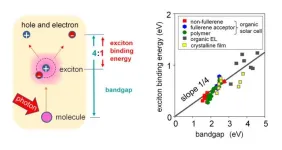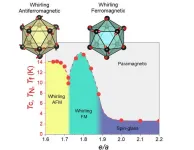Lighting the path: Exploring exciton binding energies in organic semiconductors
Precise measurement of exciton binding energies in organic semiconductors reveals unexpected correlations and insights for organic optoelectronic devices
2024-01-18
(Press-News.org)
Organic semiconductors are a class of materials that find applications in various electronic devices owing to their unique properties. One attribute that influences the optoelectronic property of these organic semiconductors is their "exciton binding energy," which is the energy needed to divide an exciton into its negative and positive constituents. Since high binding energies can have a significant impact on the functioning of optoelectronic devices, low binding energies are desirable. This can help in reducing energy losses in devices like organic solar cells. While several methods for designing organic materials with low binding energies have been investigated, accurately measuring these energies remains a challenge, primarily due to the lack of suitable energy measurement techniques.
Advancing research in this domain, a team of researchers led by Professor Hiroyuki Yoshida from the Graduate School of Engineering at Chiba University, Japan, have now shed light on the exciton binding energies of organic semiconductors. Their study was recently published online in The Journal of Physical Chemistry Letters on 11 December 2023. Ms. Ai Sugie from the Graduate School of Engineering at Chiba University, Dr. Kyohei Nakano and Dr. Keisuke Tajima from the Center for Emergent Matter Science at RIKEN, and Prof. Itaru Osaka from the Department of Applied Chemistry at Hiroshima University were involved with Prof. Yoshida in undertaking this study. Talking to us about their study, Prof. Yoshida says, "In this study, a previously unpredicted nature of exciton binding energies in organic semiconductors was revealed. Given the fundamental nature of our research, we expect long-term and persistent effects, both visible and invisible, on real-life applications."
The team first experimentally measured the exciton binding energies for 42 organic semiconductors including 32 solar cell materials, seven organic light-emitting diode materials, and three crystalline compounds of pentacene. To compute the exciton binding energies, the researchers calculated the energy difference between the bound exciton and its "free carrier" state. While the former is given by the "optical gap," linked to light absorption and emission, the latter is given by the "transport gap," which denotes the energy needed to move an electron from the highest bound energy level to the lowest free energy level.
Experimental determination of the optical gap involved photoluminescence and photoabsorption experiments. Meanwhile, the transport gap was computed through ultraviolet photoelectron spectroscopy and low-energy inverse photoelectron spectroscopy, a technique pioneered by the research group. The use of this framework enabled the research team to determine exciton binding energies with a high precision of 0.1 electron volts (eV). The researchers believe that this precision level can help discuss the exciton nature of organic semiconductors with much higher confidence than previous studies.
Moreover, the researchers observed an unexpected aspect of the nature of exciton binding energies. They found that the exciton binding energy is one-quarter of the transport bandgap, irrespective of the materials involved.
The outcomes of this study are set to shape the fundamental principles pertaining to organic optoelectronics and also have potential real-life applications. For instance, the design principles regulating organic optoelectronic devices are expected to change favorably. Moreover, given the potential of these findings to influence concepts within the field, the researchers believe that these findings are also likely to be included in future textbooks.
Sharing his closing thoughts, Prof. Yoshida says, "Our study contributes to advancing the current understanding of the mechanism of excitons in organic semiconductors. Moreover, these concepts are not only limited to organic semiconductors but can also be applied to a wide range of molecular-based materials, such as bio-related materials."
Here's hoping that this work paves the way for more exciting developments in the field of organic semiconductors for next-generation electronics!
About Professor Hiroyuki Yoshida
Hiroyuki Yoshida is a Professor at the Graduate School of Engineering and the Molecular Chirality Research Center at Chiba University, Japan. Prof. Yoshida earned his Ph.D. from the University of Tokyo in 1995. His research focuses on functional solid-state chemistry, and he has over 90 publications and 3,100 citations to his credit. He is also the recipient of several distinguished awards, including the 8th Outstanding Achievement Award at the Japan OLED Forum in 2015, the 12th Best Paper Award from The Japan Society of Applied Physics, Molecular Electronics and Bioelectronics in 2014, and the Best Oral Presentation Award at the Grand Renewable Energy 2014 International Conference.
END
[Attachments] See images for this press release:

ELSE PRESS RELEASES FROM THIS DATE:
2024-01-18
Quasicrystals are intermetallic materials that have garnered significant attention from researchers aiming to advance condensed matter physics understanding. Unlike normal crystals, in which atoms are arranged in an ordered repeating pattern, quasicrystals have non-repeating ordered patterns of atoms. Their unique structure leads to many exotic and interesting properties, which are particularly useful for practical applications in spintronics and magnetic refrigeration.
A unique quasicrystal variant, known as the Tsai-type icosahedral quasicrystal (iQC) and their cubic approximant crystals (ACs), display intriguing characteristics. These include long-range ferromagnetic (FM) ...
2024-01-18
Researchers at Karolinska Institutet in Sweden have used DNA origami, the art of folding DNA into desired structures, to show how an important cell receptor can be activated in a previously unknown way. The result opens new avenues for understanding how the Notch signalling pathway works and how it is involved in several serious diseases. The study is published in Nature Communications.
Notch is a cell receptor that is of great importance to a wide range of organisms and plays a crucial role in many different processes, including early embryonic development in both flies and humans. Notch ...
2024-01-18
The mystery behind why Alaskan horses, cryptodiran turtles and island lizards shrunk over time may have been solved in a new study.
The new theoretical research proposes that animal size over time depends on two key ecological factors: the intensity of direct competition for resources between species, and the risk of extinction from the environment.
Using computer models simulating evolution, the study, published today (Thursday, 18 January) in communications biology, identifies why some species gradually get smaller, as indicated by fossil records.
Dr Shovonlal Roy, an ecosystem modeller from the University of Reading who led the research, ...
2024-01-18
Researchers from The University of Texas MD Anderson Cancer Center reported promising results in a Phase I/II trial of 37 patients with relapsed or refractory B-cell malignancies who were treated with cord blood-derived chimeric antigen receptor (CAR) natural killer (NK) cell therapy targeting CD19.
Published today in Nature Medicine, the findings reveal an overall response (OR) rate of 48.6% at 100 days post treatment, with one-year progression-free survival (PFS) and overall survival (OS) rates of 32% & 68%, respectively. The trial reported an excellent safety profile with no cases of severe cytokine release syndrome (CRS), neurotoxicity, ...
2024-01-18
· New finding to understand brain cell loss in neurodegenerative disease
· Increasing protective short RNAs may be new approach to halt or delay Alzheimer’s
· SuperAgers with superior memories have more protective short RNAs in their brains
CHICAGO --- Alzheimer’s disease, which is expected to have affected about 6.7 million patients in the U.S. in 2023, results in a substantial loss of brain cells. But the events that cause neuron death are poorly understood.
A new Northwestern Medicine study shows that RNA interference may play a key role in Alzheimer’s. For the first time, ...
2024-01-18
The way science is funded is hampering Earth System Models and may be skewing important climate predictions, according to a new comment published in Nature Climate Change by Woodwell Climate Research Center and an international team of model experts.
Emissions from thawing permafrost, frozen ground in the North that contains twice as much carbon as the atmosphere does and is thawing due to human-caused climate warming, are one of the largest uncertainties in future climate projections. But accurate representation of permafrost dynamics is missing from ...
2024-01-18
A team of researchers from China, Australia, France, Spain, and Germany has revealed advanced material culture in East Asia by 45,000 years ago.
The new study was published in Nature Ecology & Evolution on Jan. 18.
The researchers examined a previously excavated archaeological collection from the Shiyu site, located in Shanxi Province.
"Our new study identified an Initial Upper Palaeolithic archaeological assemblage from the Shiyu site of North China dating to 45,000 years ago that includes blade technology, tanged and hafted projectile points, long-distance obsidian transfer, and the use of a perforated ...
2024-01-18
Throughout the brain’s cortex, neurons are arranged in six distinctive layers, which can be readily seen with a microscope. A team of MIT neuroscientists has now found that these layers also show distinct patterns of electrical activity, which are consistent over many brain regions and across several animal species, including humans.
The researchers found that in the topmost layers, neuron activity is dominated by rapid oscillations known as gamma waves. In the deeper layers, slower oscillations called alpha and beta waves ...
2024-01-18
200 US communities will fail to transition to 100% renewable energy by 2050 despite their pledges to do so, according to a new study published in IOP Publishing’s journal Environmental Research: Infrastructure and Sustainability.
The study shows that by 2050 gas will firmly remain the primary source of energy in the US given that the current infrastructure plans for implementing renewable energy cannot provide sufficient energy output. Recent projections suggest that renewable energy generation will need to triple to meet even a 45% share of energy production. The results indicate that in many instances renewable energy ...
2024-01-18
The European Society of Endocrinology (ESE) is pleased to announce that the new Editor-in-Chief of our flagship journal, the European Journal of Endocrinology (EJE), is Professor Felix Beuschlein, M.D. He will assume his post in May 2024 when the current Editor in Chief, Professor Wiebke Arlt, steps down.
Professor Philippe Chanson, Chair of ESE’s Publications and Communications Committee said, “I am delighted that Felix will be the next Editor in Chief of ESE’s flagship journal and will continue to build on the strong foundations laid by his predecessors. Felix’s internationally ...
LAST 30 PRESS RELEASES:
[Press-News.org] Lighting the path: Exploring exciton binding energies in organic semiconductors
Precise measurement of exciton binding energies in organic semiconductors reveals unexpected correlations and insights for organic optoelectronic devices





